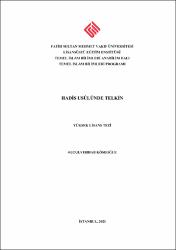| dc.contributor.advisor | Kutlay, Halil İbrahim | |
| dc.contributor.author | Köseoğlu, Abdulvehhab | |
| dc.date.accessioned | 2021-08-19T15:31:08Z | |
| dc.date.available | 2021-08-19T15:31:08Z | |
| dc.date.issued | 2021 | en_US |
| dc.identifier.citation | KÖSEOĞLU, Abdulvehhab, Hadis Usûlünde Telkin, Fatih Sultan Mehmet Vakıf Üniversitesi Lisansüstü Eğitim Enstitüsü Temel İslam Bilimleri Anabilim Dalı Temel İslam Bilimleri Programı,Yayımlanmamış Yüksek Lisans Tezi, İstanbul 2021. | en_US |
| dc.identifier.uri | https://hdl.handle.net/11352/3830 | |
| dc.description.abstract | Râvînin aşırı gafletinden ya da hafızasının zayıflamasından yararlanarak kendisine ait olmayan bazı rivayetlerin kendi hadisiymiş gibi sunulmasına Hadis Usûlünde “Telkin” denilmektedir. Râvînin kendisine telkin edilen hadisleri kendi hadisiymiş gibi kabul edip tahdîs etmesi yani telkini kabul etmesi çok önemli bir zabt kusurudur.
Râvînin telkini kabul etmesinin sebepleri arasında aşırı dalgınlık, dikkatsizlik, hafıza zayıflığı ve çevresine aşırı güven duyması bulunmaktadır. Telkini kabul eden râvî, kendisinin ya da telkin yapan kimsenin itirafı ile veya rivayetlerin karşılaştırılması yahut şahitlerin beyanıyla tespit edilir.Önceleri daha çok râvînin zabtını ölçmek veya eğitim kastıyla uygulanan telkin, daha sonraları maalesef hadis uydurmak için de kullanılmıştır. Râvînin zabtını deneme ve eğitim kastıyla icra edilen telkin eylemi, alimler tarafından caiz görülürken rivayeti olmayan hadisleri üstada tahdîs edip daha sonra da ondan rivayet etme ve hadis uydurma kastıyla yapılan telkin ise caiz görülmemiştir.
Bu konuları ayrıntılı bir şekilde içeren “Hadis Usûlünde Telkin” başlıklı bu çalışma; giriş, üç bölüm ve sonuçtan oluşmaktadır. Giriş bölümünde araştırmanın konusu ve önemi, araştırmada izlenen metot ve araştırmanın kaynakları üzerinde durulmuştur.
Birinci bölümde kabul ve red açısından hadisler incelenirken konu, taʻn sebepleri çerçevesinde detaylandırılmıştır. İkinci bölümde telkin kelimesinin kavramsal çerçevesi belirlenmiş, telkin uygulamanın ve telkini kabul etmenin sebepleri örnekleriyle detaylı bir şekilde anlatılmıştır. Üçüncü bölümde ise telkinin şerʻî boyutu ile telkini yapan veya kabul eden râvînin rivayetlerinin hükmü üzerinde durulmuştur. | en_US |
| dc.description.abstract | "Talqin" in hadith methodology refers to exert some efforts to present a hadith that do not belong to him as his own by taking advantage of the excessive inattention of the narrator (rawi) or the weakness of his memory. It is a very important defect in strength of apprehension (dabt) that the narrator accepts the hadiths which are narrated to him as his own hadith by accepting talqin.
The most important reasons for the narrator to accept the talqin are his excessive distraction, carelessness, excessive trust in his friends and memory weakness. A narrator who accepts talqin is determined by the comparison of his narrations, by the confession of the narrator who made or accepting the talqin or by the statement of the witnesses In the beginning, talqin was mostly used to measure the weakness of the narrator and for educational purposes and later on, it was used to make up hadiths. If the act of talqin is carried out with the intention of trying and training the strength of apprehension of the narrator, it is permissible by the scholars. However, using talqin to make up hadiths in order to make them to be narrated by a hadith master is not permissible.
This study titled "talqin in the hadith methodology" covers abovementioned topics and includes an introduction, three chapters and a conclusion. In the introduction part, the subject and importance of the research, the method followed in the research and the sources of the research are emphasized.In the first chapter, the hadiths in terms of acceptance and rejection are examined and the subject is detailed within the framework of reasons of criticism (t'an). In the second chapter, the conceptual framework of the word talqin is determined, and the reasons for applying the talqin and accepting it are explained in detail in the light of examples. In the third chapter, the sharia dimension of the talqin and the determination of the narratives of the narrator who made or accepted the talqin were examined. | en_US |
| dc.language.iso | tur | en_US |
| dc.publisher | Fatih Sultan Mehmet Vakıf Üniversitesi, Lisansüstü Eğitim Enstitüsü | en_US |
| dc.rights | info:eu-repo/semantics/openAccess | en_US |
| dc.subject | Telkin | en_US |
| dc.subject | Zabt | en_US |
| dc.subject | Fartu’l-Gafle | en_US |
| dc.subject | Cerh ve Taʻdîl | en_US |
| dc.subject | Prompting (Talqin) | en_US |
| dc.subject | Strength of Apprehension (dabt) | en_US |
| dc.subject | Excessive Distraction (fart-al-gafle) | en_US |
| dc.subject | Hadith Critique (al-jarh wa al-taʻdil) | en_US |
| dc.title | Hadis Usûlünde Telkin | en_US |
| dc.title.alternative | Talqin in The Hadith Methodology | en_US |
| dc.type | masterThesis | en_US |
| dc.contributor.department | FSM Vakıf Üniversitesi, Lisansüstü Eğitim Enstitüsü, Temel İslam Bilimleri Ana Bilim Dalı | en_US |
| dc.relation.publicationcategory | Tez | en_US |
| dc.contributor.institutionauthor | Köseoğlu, Abdulvehhab | |



















